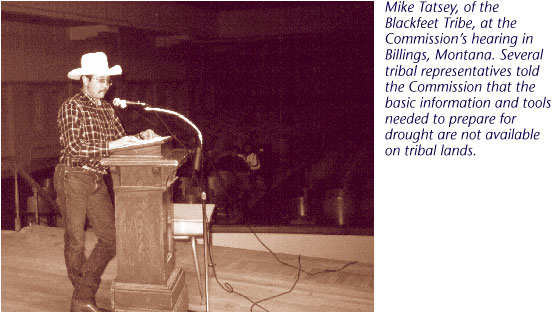|
|
| Return to Table of Contents |
|
times have proved to be no exception. Flexibility was the key to adaptation and relative self-sufficiency in earlier times. When the ability to cope in one place was exceeded, tribes moved, later returning when climate permitted. Since the loss of many of their ancestral lands, however, such flexibility is no longer possible for the tribes. Some tribes are turning to planning as a viable means of lessening the impacts of drought on tribal lands and populations. But others expressed their concerns that criteria for national drought policy might compromise their cultural or religious beliefs, and they specifically asked that this not occur. Some tribes were also reluctant to disclose water-related information because of ongoing negotiations over water rights. They asked that any national drought policy be sensitive to these issues and that the Commission uphold the special relationship that tribes have with the federal government. As a result of our outreach effort, we found that six tribes—the Hopi Tribe, Hualapai Nation, Kaibab-Paiute Tribe, Navajo Nation, San Carlos Apache Tribe, and Zuni Pueblo—are in the process of developing drought contingency plans through cooperative agreements with the Bureau of Reclamation (Appendix B, File F). Based on these experiences, developing drought plans can cost from $25,000 to $200,000. But in Billings, Montana, representatives from seven tribes consistently reported frustration in not being able to rely on the procedures and processes associated with the "Government-to-Government" Executive Order signed by President Clinton. They described the bureaucratic quagmire associated with the Bureau of Indian Affairs. Most tribal witnesses also explained that eligibility criteria and cost-share rates in many current drought-related programs must be modified to address specific tribal situations. They emphasized that such programs must be adequately funded. We learned from comments
submitted by tribes from Florida to Alaska and from the Intertribal
Agriculture Council that many tribal lands lack current soil survey,
streamgaging, and range condition information. Such information is
critical to basic planning as well as drought planning. Some tribes
indicated that they lack access to snow amount, soil moisture, and
stream flow information needed in planning and for triggering emergency
response efforts. Many tribes noted the need for technical and financial
assistance to plan and implement conservation measures such as wells,
springs, and ponds for
|
 |
|
|
